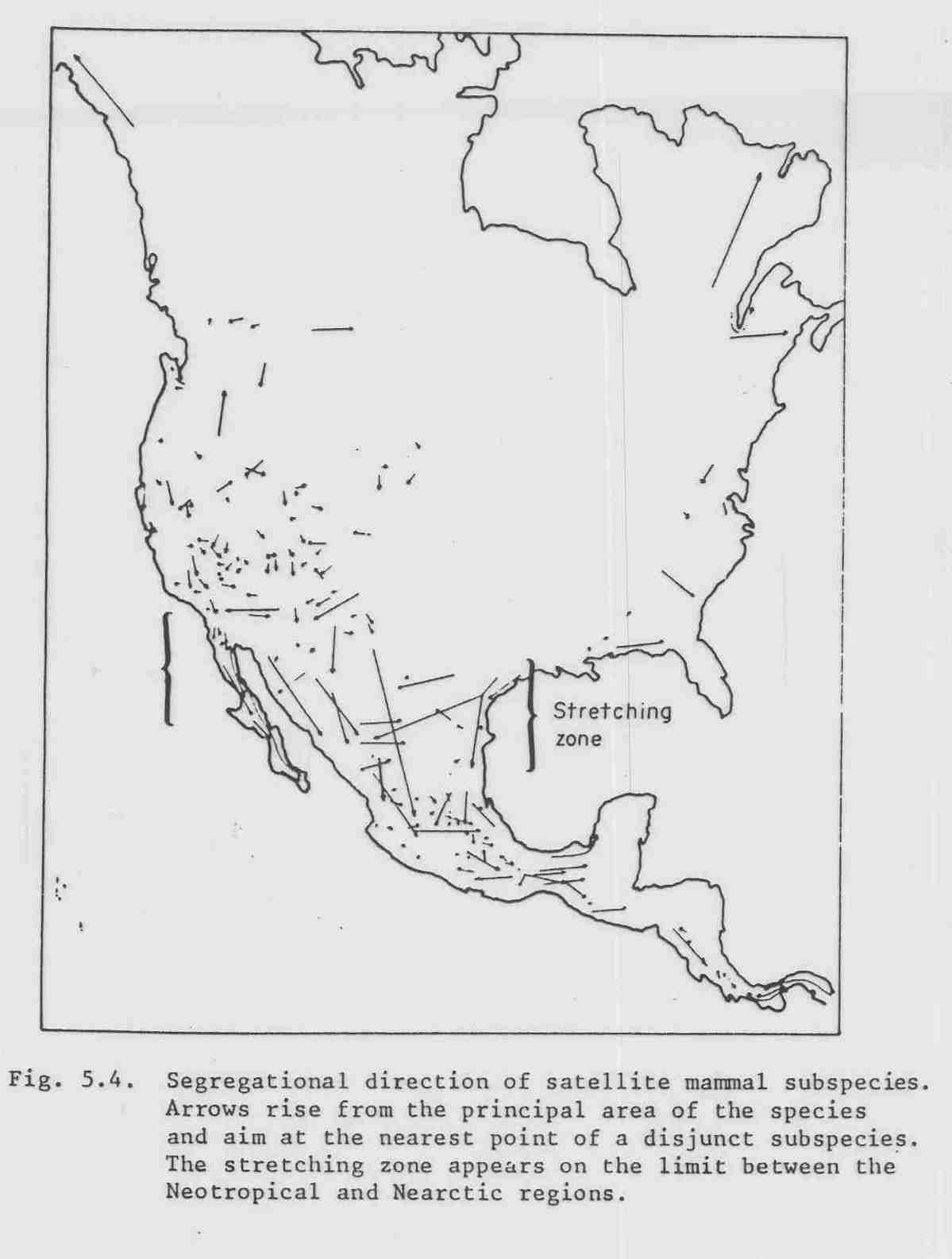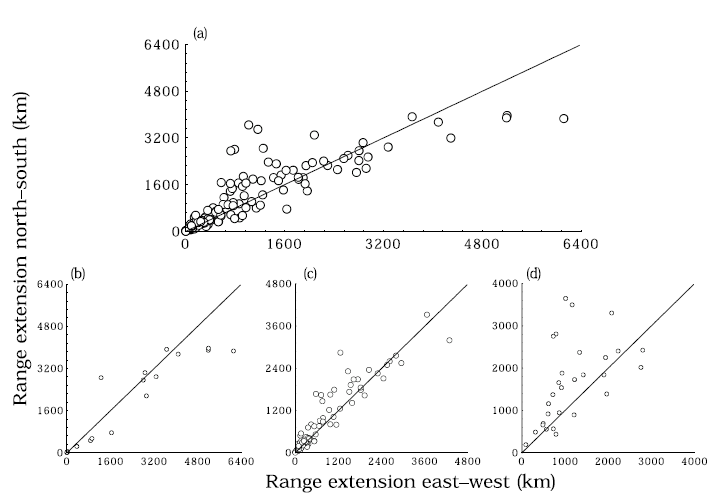BIOGEOGRAPHY, ETC.
Fall 2018
QUESTION SET 4
DUE: by end of term
1. We've
talked through a variety of ideas about the adoption of
agriculture and domestication of plants and animals in several separate
times and places. Study of the origin of agriculture encounters
challenges similar to most historical biogeography and
phylogenetic studies; it is difficult to find and test unifying
hypotheses. Some scholars argue that each of the separate and
independent cases of agricultural origin must be treated as its own
distinctive story or case study. Others continue to search for
and argue for unifying ideas that focus on commonalities of cause and
pattern. Write a paragraph or two laying out your own position on
this. Do you think it's possible to build a 'unifying theory' for
the origin of agriculture? If so, can you articulate a piece or
two of that theory as testable hypotheses? How might they be
tested?
2. We talked about the role of 'endosymbiosis' in the early evolution
of life. Accepted cases of this phenomenon involve the
incorporation of one single-celled organism into another, to the degree
that the 'iincorporated' entity becomes an 'organelle' of the other
(e.g., chloroplasts, mitochondria, perhaps flagella...). Answer TWO of
the following THREE questions about this scenario.
- Is 'symbiosis' an apt name for this phenomenon? Explain your rationale and, if you think this is not an appropriate term, suggest a better one.
- These now-accepted cases of endosymbiosis occurred
very early in the history of eukaryotic cells, well back into the
pre-Cambrian. Can you suggest a reason why the phenomenon hasn't
occurred more frequently and recently? (Remember that we talked
about some cases of modern 'connections' between different organisms
that look like 'partial' examples of such a phenomenon, like
incorporation of single-cell photoautotrophs into the tissues of
several types of animals -- but none of these have been 'completed', to
the extent that the 'partnership' (if that's the right word) is
sustained through reproductive events of both participants...).
- In the known examples of
endosymbiosis, the former-bacteria-now-organelles retain some elements
of their own original genome -- but most of the original bacterial
genome has been 'pirated' from the bacteria into the nucleus of the
'host' eukaryote. Suggest a selective/evolutionary rationale for
this.
3. Thinking into the future, what are some biogeographical and
macroevolutionary phenomena or processes, either continuing or novel,
that should be of concern with respect to human well-being. Which
of these would you think most important to address in some way.
Why? How (in simple, brief terms!)?
HERE ARE THREE
RANDOM QUESTIONS ABOUT ideas from early in the term regarding what
structures the distributions/ranges of organisms. CHOOSE ONE TO DISCUSS/ANSWER: As part of your answer, consider how relationships shown might change or constrain responses as climate changes into future.
 4. This map
from Rapoport's 'Areography'
shows separation between of ranges of disjunct subspecies from the main
range of the species (you can open image in a new tab, or save it and
open separately for a larger version); each
arrow originates from the 'main' range of the species,
and the
head of the arrow indicates the range of the subspecies (usually
smaller in extent, and considered an 'offshoot' of the parent, main
species).
Rapoport
uses the figure to illustrate what he calls a 'stretching zone' in
northern Mexico, but there are other interesting patterns.
Consider the direction of the arrows, for example.
How are
local, disjunct subpsecies generally located relative to the larger
'main' range of the species? Formulate at least one
hypothesis
for why this should be the case.
4. This map
from Rapoport's 'Areography'
shows separation between of ranges of disjunct subspecies from the main
range of the species (you can open image in a new tab, or save it and
open separately for a larger version); each
arrow originates from the 'main' range of the species,
and the
head of the arrow indicates the range of the subspecies (usually
smaller in extent, and considered an 'offshoot' of the parent, main
species).
Rapoport
uses the figure to illustrate what he calls a 'stretching zone' in
northern Mexico, but there are other interesting patterns.
Consider the direction of the arrows, for example.
How are
local, disjunct subpsecies generally located relative to the larger
'main' range of the species? Formulate at least one
hypothesis
for why this should be the case.
 5.
This figure is from Rosenfield, J. A. 2002, "Pattern and process
in the geographical ranges of freshwater fishes", Global Ecology and
Biogeography 11:323–332. The top graph represents 121 North
American freshwater fish species. Panel (b) shows species in his
'lake guild' (species occurring primarily in lakes), (c) shows his
'riverine guild', and (d) shows his 'coastal guild' (species that are
able to spend part of their life in marine environments, including
andadromous and catadromous species) (look it up!). Rosenfield
uses maximum range-extents in E-W and N-S dimensions to assess
patterns. He hypothesizes that range geometries for different
guilds are strongly influenced by the ways in which fish might
have dispersed
in the past (mainly since the last glaciation). Lake and riverine guilds can tolerate only
fresh-water, and they depend on present or past water connections to
spread between water bodies (remember that lakes/drainages have been
reorganized following glacial retreat).
5.
This figure is from Rosenfield, J. A. 2002, "Pattern and process
in the geographical ranges of freshwater fishes", Global Ecology and
Biogeography 11:323–332. The top graph represents 121 North
American freshwater fish species. Panel (b) shows species in his
'lake guild' (species occurring primarily in lakes), (c) shows his
'riverine guild', and (d) shows his 'coastal guild' (species that are
able to spend part of their life in marine environments, including
andadromous and catadromous species) (look it up!). Rosenfield
uses maximum range-extents in E-W and N-S dimensions to assess
patterns. He hypothesizes that range geometries for different
guilds are strongly influenced by the ways in which fish might
have dispersed
in the past (mainly since the last glaciation). Lake and riverine guilds can tolerate only
fresh-water, and they depend on present or past water connections to
spread between water bodies (remember that lakes/drainages have been
reorganized following glacial retreat).
A. Describe the differences in patterns for the three guilds.
B.
Can differences be described in ways consistent with Rosenfield's
hypothesis? Explain. Can you think of additional kinds of
evidence you might use to further test his hypothesis/your
interpretation (put in terms of testable predictions...)?

6. Here's a graph from an earlier edition of the optional text. Each point represents a species native to North America:
A.
Describe the pattern/relationship shown, pointing to the features you
think most interesting (in your own words/thinking; don't just echo the
textbook).
B.
Focus on the red 'constraint line'. What might you suggest about
the species that fall near or below this line? Frame your
suggestions as hypotheses. Offer a way of further
assessing/testing at least one of your ideas/hypotheses.
 4. This map
from Rapoport's 'Areography'
shows separation between of ranges of disjunct subspecies from the main
range of the species (you can open image in a new tab, or save it and
open separately for a larger version); each
arrow originates from the 'main' range of the species,
and the
head of the arrow indicates the range of the subspecies (usually
smaller in extent, and considered an 'offshoot' of the parent, main
species).
Rapoport
uses the figure to illustrate what he calls a 'stretching zone' in
northern Mexico, but there are other interesting patterns.
Consider the direction of the arrows, for example.
How are
local, disjunct subpsecies generally located relative to the larger
'main' range of the species? Formulate at least one
hypothesis
for why this should be the case.
4. This map
from Rapoport's 'Areography'
shows separation between of ranges of disjunct subspecies from the main
range of the species (you can open image in a new tab, or save it and
open separately for a larger version); each
arrow originates from the 'main' range of the species,
and the
head of the arrow indicates the range of the subspecies (usually
smaller in extent, and considered an 'offshoot' of the parent, main
species).
Rapoport
uses the figure to illustrate what he calls a 'stretching zone' in
northern Mexico, but there are other interesting patterns.
Consider the direction of the arrows, for example.
How are
local, disjunct subpsecies generally located relative to the larger
'main' range of the species? Formulate at least one
hypothesis
for why this should be the case.
